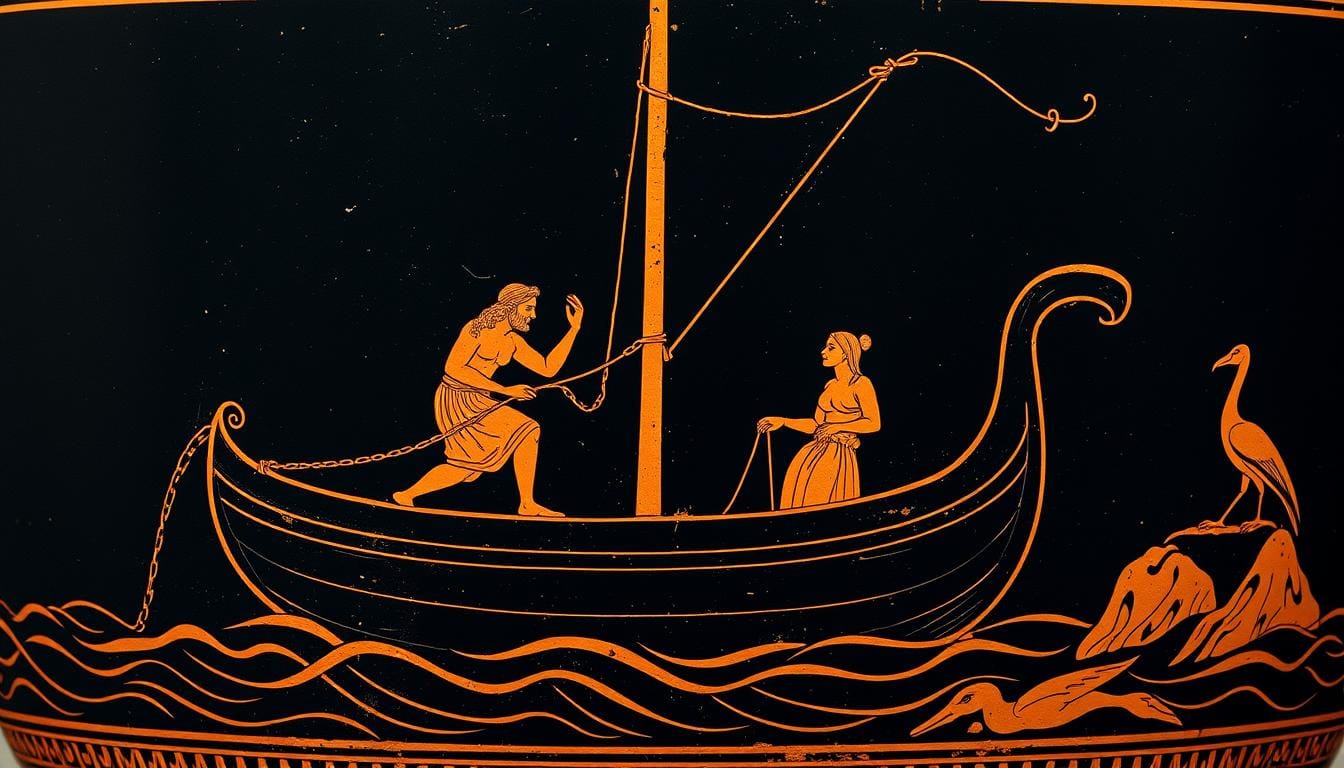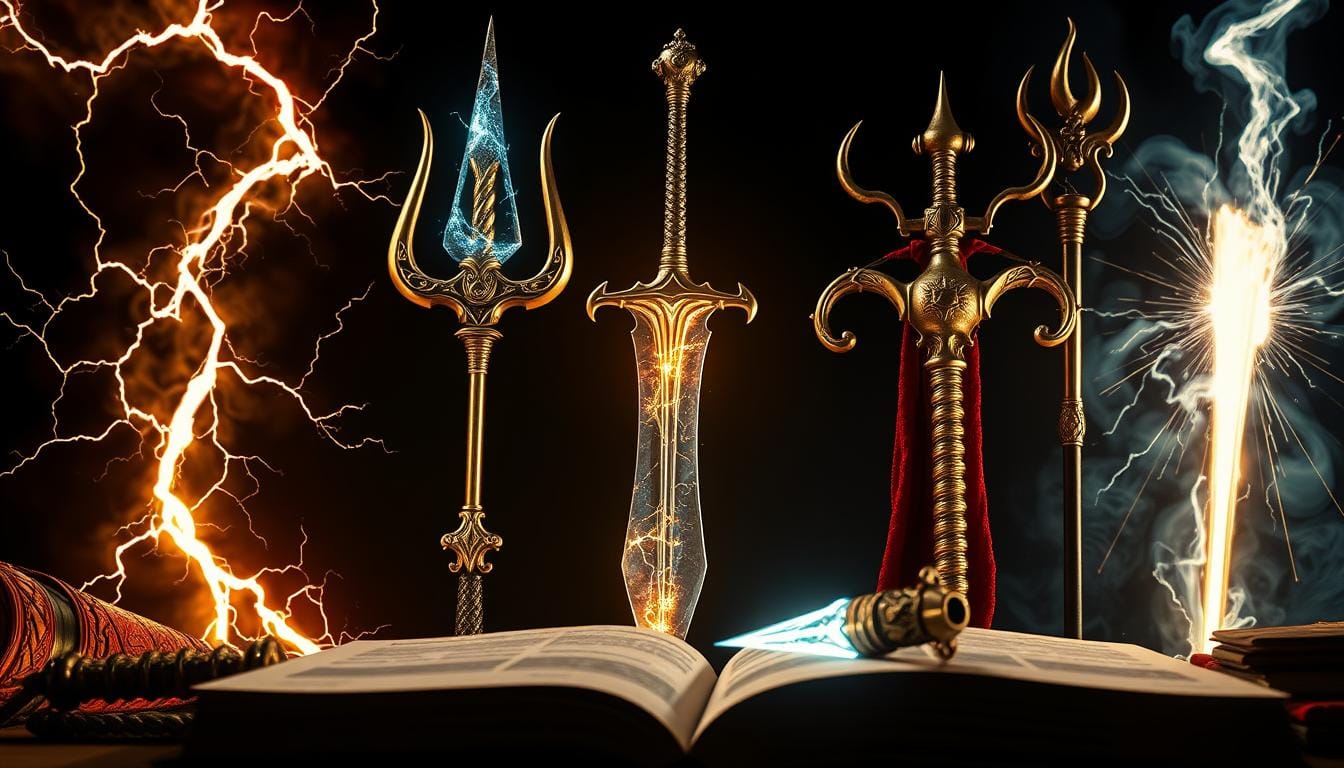Over 70% of our planet is water, but ancient people saw more. They believed in four basic elements: air, fire, water, and earth. Before we knew 118 elements, they saw the world in simple terms.
The Greek philosopher Empedocles introduced these elements around 450 BC. He called them the four “roots” of all life. These elements helped ancient civilizations understand their world, from the ground to the stars.
These elements are fascinating because they connect us all. From Greece to India, and Tibet to Angola, people saw the same patterns. They came to similar conclusions about the forces of nature.
Now, we know solid is earth, liquid is water, gas is air, and plasma is fire. The ancient ones weren’t wrong; they just used the language they had. Their ideas helped start centuries of scientific discovery.
Key Takeaways
- The primordial elements – air, fire, water, earth – were first formally described by Empedocles in 450 BC
- Ancient elements theory appeared independently in multiple civilizations worldwide
- Classical elements correspond to modern states of matter: solid, liquid, gas, and plasma
- These ancient elements provided the foundation for early scientific understanding
- Water covers 70% of Earth’s surface but represents just one of four fundamental elements
- Pre-Socratic philosophers like Thales, Anaximenes, and Heraclitus each championed different elements as primary
Understanding the Classical Elements and Their Ancient Origins
Thousands of years ago, ancient philosophers wondered about the universe’s basics. They noticed natural forces and tried to figure out what made up everything. Their search for the universe’s building blocks started early science and philosophy.
The Birth of Elemental Philosophy in Ancient Civilizations
Ancient Greek thinkers started studying elemental magic by observing nature. Thales thought water was the base of all things. Heraclitus believed fire was key. Then, Empedocles combined these ideas into the four-element system we know today.
He showed air’s existence by using a bucket in water. This proved air takes up space and stops water from filling it.
Plato linked each element to shapes. He said earth is like a cube, air an octahedron, water an icosahedron, and fire a tetrahedron. This made abstract forces easier to understand.
How the Four Elements Shaped Early Scientific Thought
The four elements were key in ancient medicine, astronomy, and alchemy. Doctors thought health came from balancing these elements in the body. Astronomers linked planets to elements, showing a connection between earth and sky.
Cultural Variations in Elemental Systems Across the World
While Greeks had their system, others had their own:
- Chinese philosophy has five elements: Metal, Wood, Water, Fire, and Earth
- Japanese tradition includes Earth, Water, Fire, Wind, and Void
- Hindu teachings mention earth, water, fire, air, and space
- African Bakongo cosmology links elements with life and directions
Different cultures saw the world in their own ways. This diversity adds to our understanding of elemental wisdom.
The Primordial Elements – Air, Fire, Water, Earth

For ages, scholars have seen the world through four key elements. These primordial elements help us understand our world and our spirits. Each element has special qualities that affect everything from weather to our moods.
Defining Each Element's Core Characteristics
Aristotle said fire is hot and dry, with qualities of sharpness and mobility. Air is a mix of heat and moisture, being both soft and strong. Water is cold and wet, flowing smoothly. Earth is cold and dry, solid and stable.
These traits go beyond just temperature and moisture. Fire changes and cleans things. Air carries thoughts and messages. Water adapts and feeds. Earth supports growth and stability. Together, they keep nature in balance.
The Interconnected Nature of Elemental Forces
Each element works together, forming our world’s complex beauty. Rain (water) feeds the soil (earth), which grows plants. These plants release oxygen into the air and fuel for fire. This shows how balance among elements supports life.
Symbolic Meanings and Archetypal Representations
Each element also has deep symbolic meanings. Fire stands for passion, change, and strength. Air is about thinking, talking, and freedom. Water is for feelings, insight, and healing. Earth is about stability, wealth, and the real world. These meanings are shared across cultures, showing universal truths about the primordial elements and their impact on us.
Air: The Breath of Life and Movement

Air is a vital element that keeps us alive with every breath. It surrounds us, supporting our bodies and connecting all living things. This invisible force is essential for life.
Air’s makeup shows nature’s perfect balance. Ancient thinkers saw air as pure. Today, we know it’s a mix of gases working together:
| Gas Component | Percentage | Role in Life |
|---|---|---|
| Nitrogen | 78% | Dilutes oxygen, prevents rapid oxidation |
| Oxygen | 21% | Essential for respiration and energy |
| Argon | 0.9% | Inert gas providing stability |
| Carbon Dioxide | 0.04% | Plant food, climate regulation |
Long before science, ancient wisdom understood air’s power. Hindu philosophy calls it vāyu, seen through hearing and touch. Buddhist teachings highlight air’s expansive, moving nature.
The balance of air’s components is key to our survival. Too much oxygen could harm us and spark fires. Nitrogen and argon keep the mix just right, showing how elements support life through unseen forces.
Fire: The Transformer and Catalyst of Change

Fire is a powerful force in nature, seen in everything from a candle’s glow to lightning’s intense heat. It changes everything it touches through a chemical reaction. This reaction needs oxygen, fuel, and heat to happen.
The Dual Nature of Fire: Creation and Destruction
Fire is a paradox in nature. It brings warmth and light, but can also cause destruction. Our bodies use fire-like processes to turn food into energy. Alchemists like Paracelsus studied fire’s different aspects, like flames, smoke, and ash.
Fire as a Symbol of Passion and Willpower
In magic, fire is linked to our drive and will. It symbolizes our passions and the spark that starts our actions. Fire helps us overcome challenges with determination.
Sacred Fire Rituals Throughout History
Many cultures have celebrated fire’s power in rituals. In Hinduism, agni (fire) is seen as divine. It’s heard, felt, and seen. Fire is used in many traditions to mark important moments and connect us to something bigger.
Water: The Source of Life and Emotional Depths

Water is key to life on Earth. It flows, adapts, and changes, making it special. Water keeps us alive, cleanses us, and connects us all. It shapes our world and touches our hearts.
Water's Role in Purification and Renewal
Water is nature’s cleaner. It dissolves more than any other liquid. This lets it carry nutrients and minerals to us.
Rain, rivers, and oceans keep our planet fresh. They help our atmosphere by absorbing carbon dioxide. Water’s cycle of renewal keeps life balanced.
The Flowing Nature of Emotions and Intuition
Water reflects our emotions, always changing. Like water, our feelings flow and change. Ancient wisdom teaches us to be emotionally flexible.
Sacred Waters and Healing Springs
Water has always been sacred. Places like the Ganges River and Lourdes show its spiritual side. These spots remind us of water’s power for spiritual and emotional healing.
Earth: The Foundation of Stability and Growth

Earth is the most solid and grounding element among the classical ones. We see it every day in the ground we walk on, the mountains, and the soil that feeds plants. It’s not just solid matter; it’s about stability, endurance, and the base of life.
The elements of air, fire, water, and earth each have their roles in nature’s balance. But earth is key for life to exist. Our planet’s crust is full of minerals and metals, with oxygen and silicon being the main ones. This mix creates the varied landscapes we see, from deserts to valleys where civilizations have thrived for ages.
The symbolism of earth links it to solidity, permanence, and patience. Ancient Greeks saw earth as cold and dry, comparing it to the cube for its stability. In Eastern traditions, like Hindu philosophy, earth is linked to all five senses, making it easy for humans to understand.
Earth’s layers show nature’s complexity. From the solid crust to the molten outer core and the dense inner core, each layer helps keep our planet stable. Earth teaches us about growth, cycles, and the need for strong foundations in life.
Elemental Balance and Harmony in Nature
Nature shows us how to keep things in balance. Plants take in carbon dioxide and give out oxygen. We do the opposite, breathing in oxygen and out carbon dioxide. Water carries nutrients through soil, feeding life everywhere.
These forces work together in a dance that has lasted for millions of years. It’s a beautiful example of how nature keeps things stable.
How Natural Forces Maintain Equilibrium
The ancient elements interact to keep our world stable. Wind and water shape our landscapes, moving sand and rock. This creates new terrains.
Temperature changes, driven by fire, create weather patterns. These patterns spread moisture across the world. Jet streams, moving at 250 mph, help control global temperatures.
The Consequences of Elemental Imbalance
When nature’s balance is upset, big problems happen. Too much heat turns fertile lands into deserts. Too much water causes floods that destroy homes.
Buddhist medicine teaches that health comes from balance. Ancient Greeks also believed in the importance of balance for well-being.
Observing Elemental Cycles in the Natural World
The Bakongo cosmogram shows how elements relate to life cycles. Air brings new life in spring, fire sparks it in summer. Earth provides growth in fall, and water rests in winter.
We see these cycles in nature, from seasons to daily weather. Understanding them helps us see how balance supports life on Earth.
Elemental Magic and Spiritual Practices
Elemental magic has been key in spiritual traditions across the globe. Ancient people saw air, fire, water, and earth as ways to understand and change. These ideas shape spiritual paths today.
Medieval alchemists turned four elements symbolism into a spiritual science. They thought each element held secrets of the universe. Their work linked science and mysticism.
| Tradition | Element Practice | Spiritual Purpose |
|---|---|---|
| Hindu Ayurveda | Panchamahabhuta meditation | Balance body and mind through sensory awareness |
| Buddhist Tantra | Five Buddha visualization | Transform negative emotions into wisdom |
| Sacred Rituals | Fire ceremonies | Purification and renewal of spirit |
| Shamanistic Practice | Earth grounding | Connect with ancestral wisdom |
Buddha taught to see the elements in ourselves. Earth is in our bones and muscles. Water is in our blood and fluids. Fire is our body heat. Air is with each breath. This helps us understand elemental magic in ourselves.
Sacred rituals use all four elements to create deep experiences. Water cleanses. Fire energizes. Earth grounds. Air carries prayers. Together, they make a complete spiritual practice.
Modern Applications of Ancient Elements Wisdom
Ancient wisdom about classical elements is shaping our modern world. It influences healing practices and environmental science. Understanding air, fire, water, and earth gives us valuable insights for today’s life.
These timeless concepts help us face complex challenges. They also keep us connected to nature’s forces.
Elemental Theory in Contemporary Healing Practices
Traditional healing systems worldwide use elemental balance. Tibetan medicine looks at five elements for health. Practitioners find imbalances to diagnose and treat.
Ayurvedic medicine also balances three doshas, which match elemental combinations. This approach helps heal the body and mind.
Today, holistic practitioners mix ancient wisdom with modern medicine. They see our bodies as mirrors of the elements. Solid tissues are earth, fluids are water, breath is air, and metabolism is fire.
Environmental Science and the Four Elements
Scientists study natural forces through an elemental lens every day. Climate researchers look at air, ocean, soil, and sun to understand weather. This helps predict and solve environmental issues.
Firefighters use elemental knowledge to fight fires. They remove heat, fuel, or oxygen. This saves lives and property.
Water cycle studies show how elements keep Earth balanced. Evaporation, precipitation, and groundwater flow are key.
Personal Development Through Elemental Understanding
Psychologists and life coaches use elemental archetypes. They help people understand their personalities and growth. Each element has qualities: earth for stability, water for adaptability, fire for passion, and air for intellectual curiosity.
Knowing these patterns helps in personal growth. It also improves relationships with others who have different elemental strengths.
Conclusion
The elements of air, fire, water, and earth have shaped our view of nature for thousands of years. From ancient teachings to today’s science, these elements guide us. The periodic table may have replaced the old system, but their wisdom stays with us.
In cultures from Greece to Africa, people saw these elements as fundamental. This shows that humans worldwide noticed similar patterns in nature. These elements influence healing, spirituality, and how we tackle environmental issues. They connect ancient wisdom with today’s knowledge.
Learning about elemental magic and balance helps us in many ways today. Climate scientists, holistic healers, and firefighters use ancient knowledge. The elements teach us about nature’s interconnected systems, important for facing global challenges.
Exploring these elements reveals timeless truths about balance and transformation. Whether through science, spirituality, or observation, they offer deep insights. They help us understand the natural world and ourselves.
FAQ
What are the four classical elements and who first proposed them?
The four classical elements are earth, water, air, and fire. Greek philosopher Empedocles first proposed them around 450 BC. He believed they explained all matter and natural phenomena.
These elements were widely accepted in many civilizations. This includes Greece, India, Tibet, Angola, and Mali.
How do the classical elements relate to modern states of matter?
The classical elements match up well with modern states of matter. Earth is like solids, water is like liquids, air is like gases, and fire is like plasma. Ancient philosophers were very observant about matter’s basic behaviors.
Even though we now use the periodic table, this connection shows their insight.
What is elemental magic and how is it practiced today?
Elemental magic is about spiritual and healing practices. It works with earth, water, air, and fire. Today, we see it in Traditional Tibetan medicine and Ayurvedic medicine.
It’s also in sacred rituals like fire ceremonies and water purification. These practices aim to restore balance for our wellbeing.
How do different cultures interpret the classical elements?
Different cultures have their own ways of seeing the elements. Greek tradition uses four elements. Chinese wuxing includes Metal, Wood, Water, Fire, and Earth.
Japanese godai features Earth, Water, Fire, Wind, and Void. Hindu panchamahabhuta includes earth, water, fire, air, and space. African traditions like the Bakongo cosmogram incorporate five elements with life cycles and cardinal directions.
What role do the four elements symbolism play in maintaining natural balance?
The elements keep balance through cycles. Water and air cause erosion that reshapes landscapes. Plants and humans exchange oxygen and carbon dioxide.
Water dissolves and transports nutrients through soil. Temperature variations create weather patterns. When these forces are out of balance, we see problems like droughts or floods.
How did Aristotle expand on the theory of classical elements?
Aristotle added a fifth element called aether. He believed heavenly bodies couldn’t be made of earthly substances. He also defined elements as bodies that cannot be divided into different forms.
He related each element to sensible qualities: Fire (hot and dry), Air (hot and wet), Water (cold and wet), and Earth (cold and dry). This framework influenced Western thought for centuries.
What practical applications do the ancient elements have in modern life?
We use elemental wisdom in many ways. Firefighters use elemental knowledge to extinguish fires. Environmental scientists study water cycles and atmospheric composition.
Climate scientists examine elemental interactions affecting global temperatures. Holistic health practitioners use elemental balance in treatments. Even personal development programs use elemental archetypes for growth.





